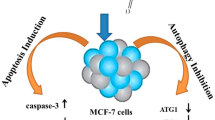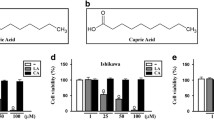Abstract
Breast cancer is one of the common tumors occurring in woman and despite treatment, the prognostic is poor. Genistein, a soy isoflavone, has been reported to have chemopreventive\chemotherapeutic potential in multiple tumor types. Here, we investigated the genistein antiproliferative effect in MCF-7 breast cancer, underlying the molecular mechanisms involved in this effect. MCF-7 cancer and CCD1059sK fibroblast cells were treated with estradiol (10 nM) or genistein (0.01–100 μM) for 24, 48, and 72 h and the cell proliferation was investigated by MTT; membrane cell permeability was evaluated by LDH and PI incorporation; apoptosis was investigated by externalization of phosphatidylserine by FACS; and presence of autophagy was detected by LC3A/B immunostaining. The expression of apoptotic proteins and antioxidant enzymes was evaluated by qPCR. The results demonstrate that genistein (100 μM) for 72 h of treatment selectively reduced MCF-7 cell proliferation independent of estrogen receptor activation, while no cytotoxicity was observed in fibroblast cells. Further experiments showed that genistein induced phosphatidylserine externalization and LC3A/B immunopositivity in MCF-7 cells, indicating apoptosis and autophagy cell death. Genistein increased in three times proapoptotic BAX/Bcl-2 ratio and promoted a parallel downregulation of 20 times of antiapoptotic survivin. In addition, genistein promoted a decrease of 5.5, 9.3, and 3.6 times of MnSOD, CuZnSOD, and TrxR mRNA expression, respectively, while the GPx expression was increased by 6.5 times. These results suggest that the antitumor effect of genistein involved the modulation of antioxidant enzyme and apoptotic signaling expression, which resulted in apoptosis and progression of autophagy.






Similar content being viewed by others
References
Langlands FE, Horgan K, Dodwell DD, Smith L (2013) Breast cancer subtypes: response to radiotherapy and potential radiosensitization. Br J Radiol 86(1023):20120601
Grover PL, Martin FL (2002) The initiation of breast and prostate cancer. Carcinogenesis 23(7):1095–1102
Sui M, Zhang H, Fan W (2011) The role of estrogen and estrogen receptors in chemoresistance. Curr Med Chem 18(30):4674–4683
Gencel VB, Benjamin MM, Bahou SN, Khalil RA (2012) Vascular effects of phytoestrogens and alternative menopausal hormone therapy in cardiovascular disease. Mini Rev Med Chem 12(2):149–174
Peto J (2001) Cancer epidemiology in the last century and the next decade. Nature 6835(411):390–395
Makiewicz L, Garey J, Adlercreutz H, Gurpide E (1993) In vitro bioassays of non-steriodal phytoestrogens. J Steroid Biochem Mol Biol 45:399–405
Kao Y, Zhou C, Sherman M, Laughton CA, Chen S (1998) Molecular basis of the inhibition of human aromatase (estrogen synthetase) by flavone and isoflavone phytoestrogens: a site-directed mutagenesis study. Environ Health Perspect 106:85–92
Adlercreutz H, Honjo H, Fotsis T, Hamalainen E, Hasegawa T, Okada H (1991) Urinary excretion of lignans and isoflavonoid phytoestrogens in Japanese men and women consuming traditional Japanese diet. Am J Clin Nutr 54:1093–1100
Jarrell J, Foster WG, Kinniburgh DW (2012) Phytoestrogens in human pregnancy. Obstet Gynecol Int. doi:10.1155/2012/850313
Setchell KDR, Borriello SP, Huhne P, Kirk DN, Axelson M (1984) Nonsteroidal estrogen of dietary origin: possible roles in hormone dependent disease. Am J Clin Nutr 40:569–578
Banerjee S, Li Y, Wang Z, Sarkar FH (2008) Multi-targeted therapy of cancer by genistein. Cancer Lett 269(2):226–242
Yu Z, Li W, Liu F (2004) Inhibition of proliferation and induction of apoptosis by genistein in colon cancer HT-29 cells. Cancer Lett 215:159–166
Fotsis T, Pepper M, Adlercreutz H (1993) Genistein, a dietary-derived inhibitor of in vitro angiogenesis. Proc Natl Acad Sci USA 90:2690–2694
Shao ZM, Wu J, Shen ZZ, Barsky SH (1998) Genistein exerts multiple suppressive effects on human breast carcinoma cells. Cancer Res 58:4851–4857
Hoffman R (1995) Potent inhibition of breast cancer cell lines by the isoflavonoid kievitone: comparison with genistein. Biochem Biophys Res Commun 211(2):600–606
Gossner G, Choi M, Tan L, Fogoros S, Griffith KA, Kuenker M et al (2007) Genistein-induced apoptosis and autophagocytosis in ovarian cancer cells. Gynecol Oncol 105(1):23–30
Yoshimori T (2004) Autophagy: a regulated bulk degradation process inside cells. Biochem Biophys Res Commun 313:453–458
Klionsky DJ, Emr SD (2000) Autophagy as a regulated pathway of cellular degradation. Science 290:1717–1721
Casciola-Rosen L, Rosen A, Petri M, Schlissel M (1996) Surface blebs on apoptotic cells are sites of enhanced procoagulant activity: implications for coagulation events and antigenic spread in systemic lupus erythematosus. Proc Natl Acad Sci USA 93(4):1624–1629
Campos VF, Collares T, Deschamps JC, Seixas FK, Dellagostin OA, Lanes CF et al (2010) Identification, tissue distribution and evaluation of brain neuropeptide Y gene expression in the Brazilian flounder Paralichthys orbignyanus. J Biosci 35(3):405–413
Begnini KR, Rizzi C, Campos VF, Borsuk S, Schultze E, Yurgel VC et al (2013) Auxotrophic recombinant Mycobacterium bovis BCG overexpressing Ag85B enhances cytotoxicity on superficial bladder cancer cells in vitro. Appl Microbiol Biotechnol 97(4):1543–1552
Nakamura Y, Yogosawa S, Izutani Y, Watanabe H, Otsuji E, Sakai T (2009) A combination of indol-3-carbinol and genistein synergistically induces apoptosis in human colon cancer HT-29 cells by inhibiting Akt phosphorylation and progression of autophagy. Mol Cancer 12(8):100
Kabeya Y, Mizushima N, Ueno T, Yamamoto A, Kirisako T, Noda T et al (2000) LC3, a mammalian homologue of yest Apg8p, is localized in autophagosome membranes after processing. EMBO J 19:5720–5728
Hsieh TC, Elangovan S, Wu JM (2010) Differential suppression of proliferation in MCF-7 and MDA-MB-231 breast cancer cells exposed to alpha-, gamma- and delta-tocotrienols is accompanied by altered expression of oxidative stress modulatory enzymes. Anticancer Res 30(10):4169–4176
Wong YS, Liu C, Liu Z, Li M, Li X, Ngai SM et al (2013) Enhancement of auranofin-induced apoptosis in MCF-7 human breast cells by selenocystine, a synergistic inhibitor of thioredoxin reductase. PLoS One 8(1):e53945
Cassidy A, Faughnan M (2000) Phyto-oestrogens through the life cycle. Proc Nutr Soc 59:489–496
Kuiper GG, Lemmen JG, Carlsson B, Corton JC, Safe SH, van der Saag PT et al (1998) Interaction of estrogenic chemicals and phytoestrogens with estrogen receptor beta. Endocrinology 139(10):4252–4263
Brandes LJ, Hermonat MW (1983) Receptor status and subsequent sensitivity of subclones of MCF-7 human breast cancer cells surviving exposure to diethylstilbestrol. Cancer Res 43(6):2831–2835
Gajewski TF, Thompson CB (1996) Apoptosis meets signal transduction: elimination of a BAD influence. Cell 87:589–592
Ahmad A, Sakr WA, Rahman KM (2012) Novel targets for detection of cancer and their modulation by chemopreventive natural compounds. Front Biosci 1(4):410–425
Waligórska-Stachura J, Jankowska A, Waśko R, Liebert W, Biczysko M, Czarnywojtek A et al (2012) Survivin-prognostic tumor biomarker in human neoplasms-review. Ginekol Pol 83(7):537–540
Firuzi O, Miri R, Tavakkoli M, Saso L (2011) Antioxidant therapy: current status and future prospects. Curr Med Chem 18(25):3871–3888
Chandra-Kuntal K, Lee J, Singh SV (2013) Critical role for reactive oxygen species in apoptosis induction and cell migration inhibition by dialyl trisulfide, a cancer chemopreventive component of garlic. Breast Cancer Res Treat 138(1):69–79
Shi JM, Bai LL, Zhang DM, Yiu A, Yin ZQ, Han WL et al (2013) Saxifragifolin D induces the interplay between apoptosis and autophagy in breast cancer cells through ROS-dependent endoplasmic reticulum stress. Biochem Pharmacol 85(7):913–926
Okuno T, Miura K, Sakazaki F, Nakamuro K, Ueno H (2012) Methylseleninic acid (MSA) inhibits 17β-estradiol-induced cell growth in breast cancer T47D cells via enhancement of the antioxidative thioredoxin/thioredoxin reductase system. Biomed Res 33(4):201–210
Karlenius TC, Shah F, Di Trapani G, Clarke FM, Tonissen KF (2012) Cycling hypoxia up-regulates thioredoxin levels in human MDA-MB-231 breast cancer cells. Biochem Biophys Res Commun 419(2):350–355
Agnani D, Camacho-Vanegas O, Camacho C, Lele S, Odunsi K, Cohen S et al (2011) Decreased levels of serum glutathione peroxidase 3 are associated with papillary serous ovarian cancer and disease progression. J Ovarian Res 22(4):18
Björkhem-Bergman L, Ekström L, Eriksson LC (2012) Exploring anticarcinogenic agents in a rat hepatocarcinogenesis model-focus on selenium and statins. Vivo 26(4):527–535
Khan MA, Chen HC, Wan XX, Tania M, Xu AH, Chen FZ et al (2013) Regulatory effects of resveratrol on antioxidant enzymes: a mechanism of growth inhibition and apoptosis induction in cancer cells. Mol Cells 35(3):219–225
Giftson JS, Jayanthi S, Nalini N (2010) Chemopreventive efficacy of gallic acid, an antioxidant and anticarcinogenic polyphenol, against 1,2-dimethyl hydrazine induced rat colon carcinogenesis. Invest New Drugs 28(3):251–259
Lambert JD, Elias RJ (2010) The antioxidant and pro-oxidant activities of green tea polyphenols: a role in cancer prevention. Arch Biochem Biophys 501(1):65–72
Dal Piaz F, Braca A, Belisario MA, De Tommasi N (2010) Thioredoxin system modulation by plant and fungal secondary metabolites. Curr Med Chem 17(5):479–494
Acknowledgments
This study was supported by the Brazilian funding agencies: CNPq-Brazil and Capes-PROAP.
Conflict of interest
The authors declare that there are no conflicts of interest.
Author information
Authors and Affiliations
Corresponding author
Rights and permissions
About this article
Cite this article
Prietsch, R.F., Monte, L.G., da Silva, F.A. et al. Genistein induces apoptosis and autophagy in human breast MCF-7 cells by modulating the expression of proapoptotic factors and oxidative stress enzymes. Mol Cell Biochem 390, 235–242 (2014). https://doi.org/10.1007/s11010-014-1974-x
Received:
Accepted:
Published:
Issue Date:
DOI: https://doi.org/10.1007/s11010-014-1974-x




